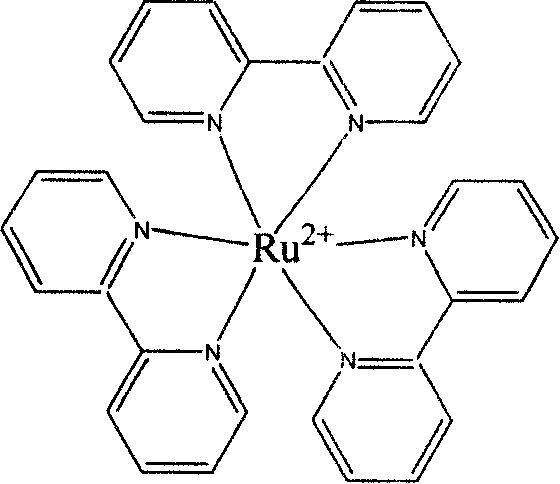Heteropoly acid catalyst with visible light photocatalysis active and preparation and application thereof
A technology of photocatalytic activity and heteropolyacid, which is applied in the direction of organic compound/hydride/coordination complex catalyst, physical/chemical process catalyst, chemical instrument and method, etc., to achieve the effect of improving photocatalytic efficiency and high degradation effect
- Summary
- Abstract
- Description
- Claims
- Application Information
AI Technical Summary
Problems solved by technology
Method used
Image
Examples
Embodiment 1
[0011] Embodiment 1: the preparation of R-PMo organic-inorganic hybrid material
[0012] Slowly add the aqueous solution dissolved with phosphomolybdic acid to the aqueous solution potassium dissolved with tri-2,2'-bipyridylruthenium dichloride, so that the ratio of the two substances is two to three, and then the mixed solution is mixed at 80 The reaction was carried out for 1 h under high temperature, and a reddish-brown precipitate was obtained. After filtering, the precipitate was washed three times with distilled water, ethanol, and ether, respectively, and dried to obtain a phosphomolybdic acid hybrid material sensitized by ruthenium dichloride 3,2,2-bipyridine.
[0013] The ultraviolet-visible spectrum of the R-PMo hybrid material was characterized by a Lambda-900 ultraviolet-visible-near-infrared spectrophotometer produced by PerkinElmer, USA. Its diffuse reflectance spectrum shows that the strongest absorption peak of the prepared R-PMo hybrid material is at 560nm. C...
Embodiment 2
[0016] Embodiment 2: Visible light photocatalytic activity test of R-PMo organic-inorganic material
[0017] Photocatalysis experiment: through a 300W high-pressure mercury lamp (using 1mol / L NaNO 2 The solution filters out light with a wavelength below 400nm) and irradiates the R-PMo organic-inorganic hybrid material to degrade organic dyes such as methyl orange, methyl blue, rose bengal, and Congo red in the aqueous solution. The specific process is as follows: the R-PMo hybrid material is dispersed into the organic dye solution, and the organic dye solution is irradiated under the stirring condition, and the wavelength range of the light source is 400-700nm.
[0018] Evaluation of photocatalytic activity: Weigh 0.05g of R-PMo hybrid material, disperse into 20ml of 20mg / L methyl orange, methyl blue, rose red, Congo red solution, irradiate under visible light for a certain period of time, and then centrifuge Separation, take the supernatant and measure the change of the abso...
Embodiment 3
[0022] Example 3: R-PMo organic-inorganic hybrid material visible light photocatalytic degradation of methyl orange solution
[0023] Refer to Example 2 for the test steps.
[0024] Degradation results: The degradation rate of methyl orange can reach 79.00% after 30 minutes of light, and the degradation rate increases linearly with the increase of light time.
PUM
| Property | Measurement | Unit |
|---|---|---|
| Specific surface area | aaaaa | aaaaa |
Abstract
Description
Claims
Application Information
 Login to View More
Login to View More - R&D
- Intellectual Property
- Life Sciences
- Materials
- Tech Scout
- Unparalleled Data Quality
- Higher Quality Content
- 60% Fewer Hallucinations
Browse by: Latest US Patents, China's latest patents, Technical Efficacy Thesaurus, Application Domain, Technology Topic, Popular Technical Reports.
© 2025 PatSnap. All rights reserved.Legal|Privacy policy|Modern Slavery Act Transparency Statement|Sitemap|About US| Contact US: help@patsnap.com


